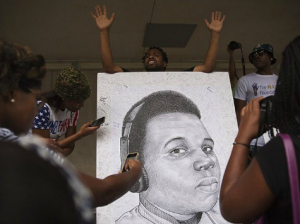According to Jerroll Sanders—the person who conceived of and drafted The Uniform Reporting Law Enforcement Improvement Act (URLEIA)—there was one aspect of the Michael Brown case she found extremely troubling. She didn’t understand how the medical examiner’s (ME’s) report refuted multiple eyewitness accounts that all claimed Darren Wilson shot Michael Brown point blank in the head. The ME’s report would prove pivotal in helping to create the defense narrative that would allow prosecutors who favored police to undermine eye-witness accounts and allow Darren Wilson to walk free.
Sanders turned to an expert medical examiner (ME) in Michigan to learn more about the autopsy process. She sought to determine the degree to which a second autopsy, which Michael Brown’s family ordered, might contradict findings from the first autopsy. The expert Sanders consulted explained that the first autopsy is pretty much conclusive, since all bodily fluids are extracted during the process. He also conceded that an ME, helping exonerate Darren Wilson could, in fact, make Michael Brown’s entry wound look like an exit wound and the exit wound look like an entry wound to support Darren’s defense narrative.
The ME in the George Floyd case has already issued a troubling statement that seems to signal that the “fix” is underway:
The autopsy revealed no physical findings that support a diagnosis of traumatic asphyxia or strangulation.
The statement appears to rewrite what hundreds of millions of Americans witnessed with their on eyes. The ME goes on to note that Floyd had pre-existing medical conditions and may have had intoxicants in his system. But we all witnessed a critical fact: Floyd was alive on the ground until police officer Derek Chauvin pressed his knee into Floyd’s neck.

